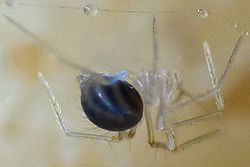| Long-legged cave spiders Temporal range: | |
|---|---|
 | |
| Telema tenella | |
 | |
| Usofila flava | |
| Scientific classification | |
| Kingdom: | Animalia |
| Phylum: | Arthropoda |
| Subphylum: | Chelicerata |
| Class: | Arachnida |
| Order: | Araneae |
| Infraorder: | Araneomorphae |
| Family: | Telemidae Fage, 1913 |
| Diversity | |
| 16 genera, 104 species | |
 | |
| blue: reported countries (WSC) green: observation hotspots (iNaturalist) | |
Telemidae, also known as long-legged cave spiders, is a family of small haplogyne spiders with about 100 described species in sixteen genera. [1] Most are cave-dwelling spiders with six eyes, though some do not have any eyes at all.